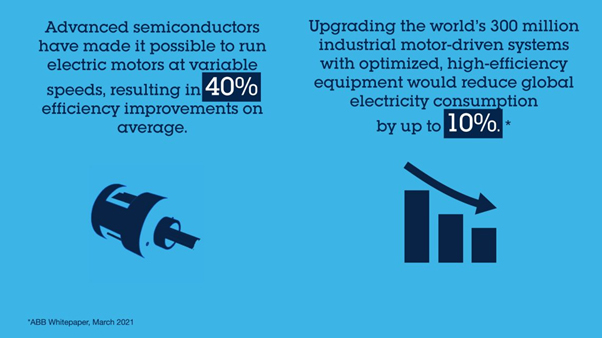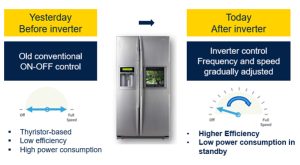Author: STMicroelectronics
Electric motors are everywhere – in our homes, factories, cars, office equipment, and countless other places. There are about 8 billion in use within the European Union (EU) ranging from tiny motors, such as those driving cooling fans in computers, to huge motors in heavy industries, accounting for nearly 50% of member states’ total electricity consumption. In an industrial context, this figure is even higher with nearly 70% of electrical usage due to electric motors. Upgrading to energy-efficient technology through motor control is a simple and cost-effective way to lower energy consumption and associated carbon emissions. Semiconductors play a significant role in advancing energy efficiency in motors through digital technologies and improved power electronics.
The new imperative to save power
In the past, there was no real impetus to design power-efficient domestic appliances or industrial equipment, as government regulations did not require this. Times have changed, thankfully. Energy efficiency labeling of domestic appliances in the EU has proved very successful. Manufacturers look to differentiate from their competition and appeal to consumers by ensuring their products are in the higher categories. In 2021 new updates to the program will help ensure that businesses continue to innovate and offer even more energy-efficient products.
Making motors more energy efficient
Household appliances most commonly use DC motors. One way in which the efficiency of DC motors is being improved is by moving away from the traditional brushed arrangements, toward brushless alternatives. These run much smoother, plus they are much more reliable. The speed motors run at is another area being addressed. Until recently, electric motors just had two speeds: on and off. This ‘all or nothing’ approach was highly inefficient. Systems were unable to respond to real-world scenarios and large amounts of energy were unnecessarily wasted.
Advanced semiconductors have made it possible to run electric motors at variable speeds, resulting in 40% efficiency improvements on average.
What this means for domestic appliances and industrial systems
Having variable-speed motors in household goods is making a real difference. Take a refrigerator, for example. Before, when a refrigerator’s internal temperature rose above its ideal set point, the motor would work until a temperature well below that value was reached. Then, when the temperature went back up, the cycle had to be repeated. This meant that a considerable amount of energy was wasted each time, due to a continuous pattern of overshoots.
Variable speed motors which have been made possible via innovations in semiconductor technology allow manufacturers of refrigerators, and other white goods, to avoid these inefficiencies. The basic idea is illustrated below. Sensors inside the appliance give it the data needed for intelligent control. The appropriate amount of power can then be delivered to the motor.
The motors in the compressors of the latest refrigerator models are directed to turn on – just often enough and at just the right speed – to maintain the appliance at the correct temperature. There are no wide temperature fluctuations, no overshoots, and power consumption is kept to an absolute minimum. Systems of this kind can react to changing conditions. For instance, opening and closing the refrigerator door multiple times while preparing a meal lets the cold escape. To restore the correct temperature level, the refrigerator system spins the motor in the compressor faster. Based on preset directives, that temperature level can be reached quickly, or more slowly to better conserve energy. Having more sophisticated industrial and domestic appliance systems, where data is continuously captured in real-time, means that they can run optimally. As the energy wasted by the system is curbed, the quantities of unwanted heat are also reduced.
This is advantageous for industrial drives, making them less dependent on cooling mechanisms, such as fans, which also require electricity. Electric motors in industrial processing plants and production sites are used to power cutting/milling machines, presses, fans, pumps, industrial drives, conveyor belts, etc. These items of equipment have long working lifespans, remaining in service for several decades and not being that regularly replaced. However, they can be retrofitted with variable-speed motors to enhance their capabilities and make them more environmentally friendly. Elsewhere, new industrial system designs, such as robotic arms and automated guided vehicles (AGVs), are embracing variable speed motors. According to independent research, upgrading the world’s 300 million industrial motor-driven systems with optimized, high-efficiency equipment would reduce global electricity consumption by up to 10 percent. That is more than 90 percent of the annual consumption of the entire EU.
Solutions from ST
STMicroelectronics has been proactive in the field of industrial motor control for over 20 years. We offer a vast range of control solutions for all types of electric motors. These include integrated intelligent power modules and electronic systems, power control applications for motor drivers, fast and efficient power switches, and powerful and secure microcontrollers. Combined with real-time control innovations, ST’s third generation of silicon-carbide (SiC) MOSFETs for power control boost the efficiency of industrial motor drives – especially where power density, energy efficiency, and reliability are critical. ST is working with many well-known manufacturers of household appliances and industrial equipment, helping these companies to design smarter, more efficient, and better-connected devices and systems.
Motors use substantial power but there is significant potential for optimizing their energy efficiency. Promoting market uptake of efficient motors and drives is an important contribution to the fight against climate change.
https://blog.st.com/semiconductors-powering-electric-motors-efficiently/










